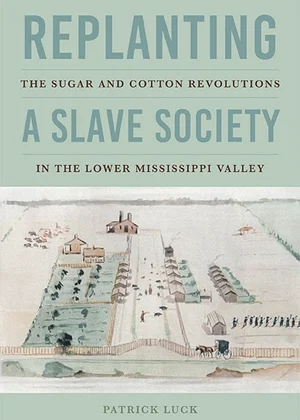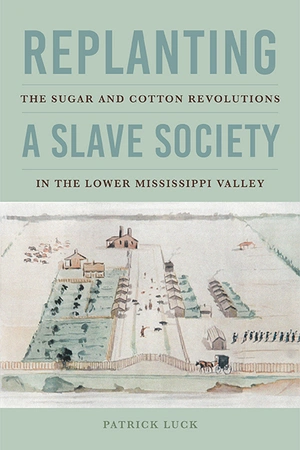

Patrick Luck is Assistant Professor of History at Florida Polytechnic University. This interview is based on his new book, Replanting a Slave Society: The Sugar and Cotton Revolutions in the Lower Mississippi Valley (University of Virginia Press, 2022).
JF: What led you to write Replanting a Slave Society?
PL: In graduate school, I came across the letters of a Louisiana enslaver named Julien Poydras. These letters introduced me to a major economic crisis in Louisiana in the 1790s and the fact that planters and farmers overcame that crisis by switching their main cash crops from indigo and tobacco to cotton and sugar over just a few years. This struck me as important considering that the main cash crop grown in a slave society is typically seen as crucial to how that slave society operated, and the cotton revolution is a crucial turning point in the history of slavery in the United States. This story became even more compelling when I learned that sugar production is very technologically sophisticated and particularly challenging in Louisiana, making its rapid adoption striking.
Later I came to understand that this crop switch was widely accepted as a crucial turning point in the region, both by contemporaries and later historians. However, I also discovered that the actual process of this switch had been largely overlooked. I think much of the explanation for this is that historians of the region have an almost obsessive, if understandable, focus on New Orleans. In practice, this has meant that the rural lower Mississippi valley, especially during the Early Republic period, has been understudied.
I concluded that figuring out why and how planters undertook these shifts and how these shifts transformed the region were fascinating puzzles and worth studying more closely, ultimately producing this book.
JF: In 2 sentences, what is the argument of Replanting a Slave Society?
PL: Lower Mississippi valley planters and other elite actors self-consciously and methodically remade their slave society in the face of severe economic and political crises in the 1790s by adopting cotton and sugar. This transformed the region from an anemic slave society to one that was prosperous and expanding by the Louisiana Purchase and laid the foundation for the extraordinarily profitable and brutal slave society that would dominate the lower Mississippi valley until the American Civil War.
JF: Why do we need to read Replanting a Slave Society?
PL: The antebellum Deep South was of crucial importance to the history of the United States: central to the American economy, the largest slave society in the world by 1860, and the home of secessionism in 1860-61. My book lays out one part of the complicated story of how that Deep South came into being. Crucial parts of that story (like this one) have too often been overlooked and oversimplified to cotton and the cotton gin.
My book also illustrates the complicated factors that went into this transformation, including revolutionary crises, slave conspiracies, and technological shifts. I also think my book is crucial because it introduces into the story of the Early Republic individuals who are not often included: Spanish imperial officials, francophone planters, and a strikingly diverse group of enslaved people with their own desires and goals. It’s a local story that decenters Anglo-Americans, in part because the crucial transformations began while the region was a Spanish colony with a predominantly francophone population.
At the end of the day, I would hope this book changes your understanding of how the South of “King Cotton” came to be (and that cotton, while maybe king, was not the sole driving force of these transformations).
JF: Why and when did you become an American historian?
PL: I became interested in history as a child through my father’s interest in military history. Later I became interested in the history of slavery and race in the United States, inspired most directly by the works of Edmund Morgan and Ira Berlin. After working for a few years in corporate America and teaching, I decided to pursue a Ph.D. in American history. My interest in being a professional historian is rooted in my (perhaps cliched) belief that you cannot understand the American present without understanding the American past, especially the complex histories of slavery and race. I’ve always been focused as much (if not more) on my teaching as my research.
JF: What is your next project?
PL: My plan is to write a group biography of three men: David, John, and Washington McDonogh. John McDonogh was an important figure in antebellum New Orleans (until 2020, when it was toppled by protesters, there was a statue of him in Lafayette Square), who was a merchant, land speculator, and sugar planter. McDonogh was a member of the American Colonization Society and freed the people he enslaved and sent them to Liberia in Africa and published a pamphlet arguing other southern enslavers should do the same. As part of this project, he sent two young enslaved men, David and Washington, to Lafayette College in Easton Pennsylvania to train them to be the doctor and minister, respectively, to the people he had enslaved once they were in Africa. Both David and Washington went on to lead fascinating lives, David as a doctor in New York and Washington as a missionary and then politician in Liberia. In each case their lives diverged markedly from what John had envisioned when he freed them. In this project I would like to explore the intersection between John’s colonizationist vision (and paternalistic anti-slavery sentiments) and the lives led by David and Washington as adults.
JF: Thanks, Patrick!